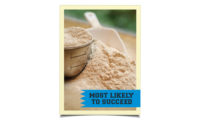They say that baccarat is entirely a game of chance — that more than any particular skill, it’s the luck of the draw that wins the “coup,” or round of play.
So as ingredient suppliers look back on 2019 — and ahead to 2020 — are they thanking their lucky stars for a winning hand? Or did shifting tastes, regulatory changes and unpredictable trends tip the game toward the house?
Milk | Cheese | Cultured | Ice Cream | Butter | Non-dairy Beverages | Ingredients | Exports
As usual, the answer depends on whom you ask. But the ingredient specialists we talked to are pretty confident that the same forces that shuffled the ingredient deck this year will keep shuffling it in the next. So get ready for more of the same — only better.
In a sense, the big trends shaping the ingredient landscape in 2019 weren’t so much about ingredients themselves as they were about consumer-driven “movements” and perceptions. And the consumers driving those movements are demanding as ever.
“Formulating new dairy products has always had its challenges, but in today’s marketplace, the table stakes are higher than ever,” noted Christine Addington, senior dairy technical service specialist, Cargill, Minneapolis. “Consumers want it all: label-friendly, reduced sugar, high protein. And, of course, it has to taste great.”
Keep it clean
Let’s start with that label-friendliness.
“Market research shows that the demand for so-called clean-label ingredients and products isn’t slowing down anytime soon,” observed Karen Nachay, senior associate editor of the Chicago-based Institute of Food Technologists’ (IFT) Food Technology magazine.
Nachay’s use of “so-called” is telling, as it underscores just how mobile a target the concept of “clean” can be. Whether it signifies the absence of gluten, GMOs, hormones, or artificial colors and flavors, the popularity of “clean label” has triggered a continuing wave of formulation “with ingredients that consumers recognize,” Nachay said.
But as Mark Fahlin, business development manager for dairy at Cargill, pointed out, clean formulation has special implications for dairy developers.
“When it comes to label-friendly ingredients,” he said, “not all food categories are created equal in consumers’ eyes. Some segments, like dairy, carry higher expectations.”
For example, Addington’s dairy customers often come to her requesting label-friendly texturizers — a tough bill to fill, given the chemically and physically complex nature of texturization.
“Texture is an area our research and development group has focused on extensively recently,” she said, “and we’ve been looking for solutions that deliver the functionality processors need yet still label simply.”
The results are coming online, as the company introduced two label-friendly texturizers in 2019. SimPure 99400 and 99405 are both waxy corn-based native starches that create “rich, satisfying” textures in dairy desserts while exhibiting process tolerance. That’s “a key need in dairy, where products may be subject to pasteurization, homogenization or ultra-high-temperature processing,” Addington said. They perform well in plant-based applications, too.
Clean-plus
Today’s concept of “clean” extends beyond a product’s actual ingredients, too.
“Consumers want to know more about a product’s journey — what was the starting ingredient, where did it come from, what type of processing did it go through?” said Jessica Arnaly, market segment manager, USA, FrieslandCampina, Amersfoort, the Netherlands.
And as far as most clean-label consumers are concerned, the gentler the processing, the better.
Arnaly pointed to her company’s Nutri whey native and Nutri whey isolate whey proteins as undergoing the kind of gentle processing that clean consumers prize.
The company derives the former directly from fresh milk, purifying it through ceramic microfiltration, while the latter comes from the whey of Dutch-type cheese.
“It’s gently heat-treated,” Arnaly explained. “And a combination of proprietary filtration technologies preserves its quality and nutritional integrity.”
The bigger picture
In 2019 — and, presumably, in 2020 — being “clean” also means speaking to global issues of climate and social responsibility.
“Consumers continue to push manufacturers for transparency, traceability and sustainability stories around the food and ingredients they formulate with,” Addington said.
In response, her company is getting the word out about its partnership with pea-protein provider Puris to develop more sustainable ways of using waste streams from pea-protein production.
“And we’ve started to see a big push behind traceability — track and trace from ‘seed to spoon’ — that’ll step-change food safety and security, enable transparency and increase accountability, including for environmental footprints,” said Maria Velissariou, chief science and technology officer for IFT. Climate and food security both “are accelerating the momentum for an integrated food-system approach.”
Linked with traceability is the notion of food provenance, said Sam Minardi, vice president, marketing, North America nutrition, ADM, Chicago.
“We expect to see an increase in the premiumization of yogurt, specifically from a global perspective, with the growth of yogurts developed in places like Iceland, Bulgaria and Russia,” he said.
And Arnaly’s observations tell her that deeply held values will continue to influence consumers’ food and beverage choices.
“They want to know they’re selecting a product made with good practices, ethical sourcing and honesty — all part of the change that’ll put our planet first,” she said.
Planting roots
One way in which consumers are turning values into action is via their support for plant-based alternatives to animal-origin foods.
“One of the biggest food-category headlines of 2019 was the success of the plant-based burger,” Nicholas Ferraro, marketing manager for DuPont Nutrition & Biosciences, St. Louis, pointed out. “From Burger King to Dunkin Donuts to KFC, everyone is rolling out a plant-based option, and that transition doesn’t stop when it hits dairy’s door.”
In fact, the plant-based boom has been at dairy’s threshold for some time, and Ferraro considers it “the elephant in the room” that’s significantly impacting dairy as a category.
“Plant-based drinkable yogurts are becoming more mainstream, while plant-based cup yogurt is reaching 3% of the overall yogurt market and still growing in double digits,” he noted. “Now that functional probiotics are being added to plant-based yogurt, we’re seeing even more health benefits around this category.”
And the trend is about more than yogurt.
“Consumer interest in and excitement about alternative options will drive innovation in products like cheeses, creams and sauces, even ice cream,” Minardi pointed out, “in the coming year.”
While the encroachment of plant-based ingredients into traditional dairy territory appears threatening, watchers of the space see no reason this has to be a zero-sum game.
What excites Addington is the continuing growth of the plant-protein trend in the dairy space. Consider that “hybrid” milks are gaining followers because consumers not only gravitate toward dairy’s health benefits, but also appreciate the “green fuzzies” that come from the inclusion of plant-based ingredients.
“I can’t wait to see what new ways dairy manufacturers will find to incorporate plant proteins into their products,” Addington said.
Ingredients get functional
Minardi wagers that 2020 will also see the continued delivery of functional ingredients in dairy products.
“This includes the addition of probiotics, fiber, protein, vitamins E and A, and antioxidants, all to meet consumers’ health and wellness needs,” he said.
Velissariou has her eye on gut microbiome research, in particular, which she said “is advancing fast, as medical and food connections as a whole are emerging.”
In fact, Heath Focus International’s (HFI) “2018 Global Trend Study” found that two in five consumers are very or extremely interested in the gut microbiome, said Jon Peters, president, Beneo Inc., Parsippany, N.J.
“They understand that a healthy microbiome positively influences the entire body, including physical health and mood,” he said.
The same study also found that three in four consumers consider digestive health very or extremely important to them, but that fully eight in 10 either suffer from digestive issues or are concerned about them. Accordingly, Beneo and HFI teamed up to identify who the key consumer targets for digestive health are, and what they’re looking for.
To wit, the one in three Americans who’s interested in digestive health, yet is currently free of digestive issues is still in the market for the mood-, energy- and weight-management benefits associated with digestive health, Peters said.
“And the every fourth consumer who’s affected by digestive issues is engaged to find a solution,” he continued. “This is reflected in their interest in fibers and prebiotics: More than half are extremely or very interested, according to HFI.”
Indeed, Arnaly noted that her company continues its focus on prebiotics and digestive health, pointing to its Vivinal GOS prebiotic as delivering scientifically supported benefits in the areas of mineral absorption, immunity and overall intestinal health.
Good-for-you tastes even better
“Continued understanding of the microbiome, the human-bacteria relationship, holistic health, traditional medicine and ancient wisdom will all drive functional ingredient use and product formulation,” observed Philip Caputo, marketing and consumer insights manager for Virginia Dare, New York. “We’re excited to see how these trends continue to shape industry.”
But as a flavor guy, Caputo is even more jazzed about functional formulation’s potential influence on dairy flavor profiles. While functional ingredients’ challenging taste profiles are usually seen as flavor problems to solve, Caputo sees them as packed with potential.
“More specifically,” he said, “the characterizing taste profiles that come from or are inspired by functional ingredients such as botanicals, spices and healing herbs — like turmeric, ginger, cinnamon, lavender and honey — will grow in popularity along with the increased emphasis on emerging health trends.”
Milk | Cheese | Cultured | Ice Cream | Butter | Non-dairy Beverages | Ingredients | Exports





